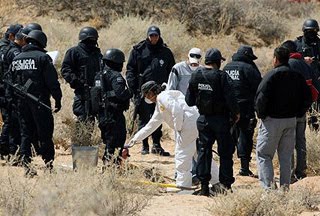Drugs, border violence, and alternative solutions

Last December, Antonio Maria Costa, head of the UN Office on Drugs and Crime, said $352 billion in criminal money was laundered and kept the financial system afloat during the worst of the crisis.
"In many instances, the money from drugs was the only liquid investment capital. In the second half of 2008, liquidity was the banking system's main problem and hence liquid capital became an important factor," he said.
Keep that in mind as we explore the increasingly unstable border between the US and Mexico. In my opinion, the recent immigration law in Arizona is wrong-headed and will solve little. That’s because it targets the wrong people. A migrant standing on a street corner waiting for a $10 an hour job isn’t the problem. But, drug cartel violence and its attendant corruption are.
Consider this.
A portion of the Buenos Aires National Wildlife Refuge in southern Arizona has been closed to the public because it is no longer safe. Drug and human smugglers use it extensively, and many of them are heavily armed. A rancher was murdered at the border recently by smugglers, police have been shot at, and corpses of smugglers have been found, apparently murdered by rival cartels. All of this happened on U.S. soil.
The sheriff of Pinal County AZ, which is 80 miles from the border, says drug cartels control parts of Arizona, that he is out-gunned and out-manned by them, and needs 3,000 U.S. troops to lend assistance. Lest you think this is paranoia or just right-wing hysteria, the Bureau of Land Management has posted a sign on Interstate 8 thirty miles from the border saying the area is dangerous and that “visitors may encounter armed criminals and smuggling vehicles traveling at high rates of speed” and to not be a hero or investigate anything, should you see something.
One reason the border is getting so hazardous in Arizona is because there is no border fence, as the area is too rugged to build one. Another is that Tohona O’odham tribal land extends from Arizona into Mexico and is thus used by drug and human smugglers.
Utah Rep. Rob Bishop says the reason the parks on the border are so dangerous is because environmental regulations restrict Border Patrol from using vehicles in those areas. Thus they can’t patrol effectively. Smugglers know this, and thus use the area more. Turf wars between the Border Patrol and the US Forest Service complicate things further. Republicans are sponsoring HR 5016 to give the Border Patrol more authority at the border. Heavy vehicle use in wildlife areas will almost certainly damage the environment, but the alternative seems worse.
Here in California, while the border isn’t as violent, we have other problems, like mega-marijuana farms being grown in national and state forest areas. They are often booby-trapped, with the land and streams polluted with pesticides, and water sources diverted. What’s left when they leave is a wasteland. Then there’s the August 2009 La Brea fire, which was caused by a cooking fire used by Mexican marijuana growers.
It’s estimated that at least 50% of drug cartel profits comes from marijuana. Along with a sensible, sane, effective border policy (which we don’t have now), maybe it’s time to consider legalizing marijuana, as it would likely cripple the cartels.
Besides, in areas like Humboldt County and Boulder CO, it already is de facto legal. Prohibition on alcohol didn’t work in the 1920’s and instead led to the growth of organized crime. Our laws against marijuana are now similarly counter-productive.
Perhaps it’s time to change them.




